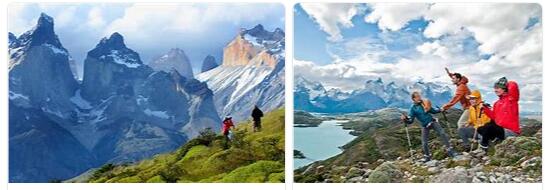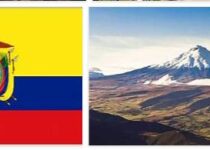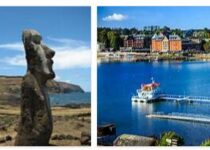Traveling in Chile
Airplane: Flights in Chile are not cheap, but they can save a lot of time. For example, a flight from Arica to Santiago only takes a few hours, while the bus takes more than a day. Aside from ferries, flights are often the only way to reach remote regions and islands in southern Chile. There are regular scheduled flights between the major Chilean cities, but advance bookings are recommended.
There are three major airlines in Chile:
Aerolineas del Sur (a subsidiary of Aerolíneas Argentinas)
LAN is the largest and oldest national airline. It offers numerous flights between Santiago and the south and north. LAN also regularly connects Santiago de Chile with Easter Island on their flight to Tahiti. From November to February, LAN flies four times a week to Easter Island, outside of this period twice a week. Advance bookings are recommended.
Sky is LAN’s main competitor and also flies numerous routes in Chile.
There are also several regional airlines in Chile, which mainly fly to the more distant southern regions and to the Juan Fernandez Archipelago (from Valparaíso and Santiago).
Most cities are not far from a domestic airport. The Aeropuerto Internacional Arturo Merino Benitez in Santiago has a separate domestic terminal, and there are also smaller airports in the capital with connections to the Juan Fernandez Islands.
Ship: South of Puerto Montt, the islands and fjords in Chilean Patagonia and Tierra del Fuego are connected by numerous ferry lines. Note, however, that many ferry services only operate within the summer season.
Important ferry routes
Hornopiren to Caleta Gonzalo
In summer, ships from Transmarchilay sail from Hornopiren around Parque Pumalin to Caleta Gonzalo.
Chiloe to Chaiten
Transmarchilay and Navimag travel between Quellon on Chiloe and Chaiten in summer. There are also connections between Castro and Chaiten in summer.
Chilean mainland to Chiloe
Regular ferries run between Pargua and Chacao in northern Chiloe.
La Arena to Puelche
Numerous ferry connections.
Puerto Ibanez to Chile Chico
Naviera Sotramin and Mar del Sur operate car and passenger ferries on Lake General Carrera. There are also connections between Chile Chico and Los Antiguos in Argentina.
Puerto Chacabuco to Puerto Natales
The ferry company Navimag operates this route.
Puerto Montt – Laguna San Rafael
Relatively expensive trips across the Laguna San Rafael are offered by Catamaranes del Sur and Cruceros Skorpios.
Puerto Montt to Chaiten
Transmarchilay operates car / passenger ferries between Puerto Montt and Chaiten. A high-speed catamaran from Catamaranes del Sur sails several times a week.
Puerto Montt to Puerto Natales
The ferry connection between Puerto Montt and Puerto Natales is particularly spectacular. Navimag offers the four-day passage between Puerto Montt and Puerto Natales on a weekly basis. However, the unpredictable Patagonian weather can mess up schedules at any time.
Puerto Montt to Puerto Chacabuco
Navimag runs from Puerto Montt to Puerto Chacabuco, from here buses go to Coyhaique and the Parque Nacional Laguna San Rafael.
Punta Arenas to Tierra del Fuego
Transbordador Austral Broom operates ferries between Punta Arenas and Porvenir, between Punta Delgada and Bahia Azul and between Tres Puentes and Puerto Williams on Isla Navarino.
Puerto Williams to Ushuaia
There is no regular ferry service.
Train: According to historyaah, Chile’s train traffic reached its peak in the late 19th century due to the transportation of raw materials from the mines. In the course of the 20th century, rail traffic sank more and more into insignificance, most of the routes are now closed. This is also due to the uneven distribution of the population in Chile.
However, there has recently been a modernized route from Santiago to Temuco via Talca and Chillan. In addition, passenger trains run between Santiago and Talcahuano (near Concepcion). A Metrotren service connects Santiago with San Fernando in the south.
With the exception of the Calama-Ollagüe connection between Chile and Bolivia, there is no passenger traffic north of Santiago. Every now and then there is the possibility to travel with a freight train from Baquedano to Socompa and on to Salta in Argentina.
Bus: Long-distance buses in Chile are punctual, reliable and comfortable. Toilets are usually located in long-distance buses, and refreshments are also available.
Most Chilean cities have a central bus station. At bus stations, the destinations, timetables and prices are usually clearly displayed. The main routes are paved (although not in large regions of the Carretera Austral south of Puerto Montt), many secondary routes consist only of slopes. The prices are cheap from a European point of view. There are fewer bus connections on the secondary routes, and the buses on these routes are also older and less comfortable.
The capital Santiago has four main bus terminals, from where buses serve the northern, central and southern regions of the country.
The largest bus company in Chile is Tur-Bus. The company operates an extensive network across the country and is known for its punctuality.
Pullman is Tur-Bus’s biggest competitor in Chile. This company also operates numerous routes throughout Chile.
The salón cama (sleeping car) and premium bus classes usually leave at night and cost up to 50% more than normal buses. However, regular buses in Chile are also comfortable, especially when compared to the buses in neighboring countries in South America.
Costs Costs
The ticket costs vary between companies and classes, so they should compare prices. Offers outside the summer season can reduce the normal fare by half, student tariffs can be 25% below the normal price.
There are numerous buses even from small towns. The prices are extremely cheap. Busses (micros) are clearly numbered and usually have a sign on the windshield with the destination. Since many identically numbered buses travel slightly different routes, pay attention to these signs. The buses are often very full, so take care of your luggage and valuables.
In numerous cities, so-called micro-buses and shared taxis run on fixed routes but without a schedule (departure is when the vehicle is full).
Car: The road network in Chile is quite good, there are around 80,000 km of roads in the country. 3,600 km of the Panamericana run from the border with Peru to Puerto Montt through Chilean territory.
Numerous motorways are subject to tolls. The maximum speed is usually 100 km / h, in places it is 50 km / h.
It is often necessary to have your own vehicle to reach remote Chilean national parks and most places off the main routes. This is especially true for the Atacama Desert and the Carretera Austral. Renting a car is the best way to explore Easter Island. There are hardly any security problems, but always lock your vehicle and do not leave any valuables in the car. Due to smog problems, there are often driving restrictions for private vehicles in Santiago and the surrounding area.
Rental prices
The major international agencies such as Hertz, Avis and Budget have branches in Santiago (including at the international airport), as well as in larger cities and tourist regions. To rent a car you must be at least 25 years old to have a valid oneHave an international driver’s license and have either a credit card (MasterCard or Visa) or a large cash deposit. Travelers from Germany, USA, Canada and Australia are not required to show an international driver’s license to rent a car. In this case, a national driver’s license is sufficient. To be on the safe side, you should still have your international driver’s license with you.
Even with smaller agencies, the car rental is quite high, the smallest vehicles cost between 40 and 65 US dollars per day (less if the vehicle is rented for one or more weeks). In addition, there are the costs for additional insurance, gasoline and 19% IVA (VAT).
One-way rental vehiclee are cumbersome or impossible to arrange. The collection fees are often relatively high. This service is practically not offered by smaller local agencies. However, some of the smaller agencies allow (at an increased cost) to drive their rental vehicle to Argentina when the car is brought back to the branch where it was rented. Chilean car insurance is not valid in Argentina.
There are limited refueling options in remote areas. Bring enough fuel with you when traveling to these regions. Car rental companies often offer canisters.
Insurance
All vehicles must take out seguro obligatorio (minimum insurance); additional liability insurance is highly recommended. Rental car companies also offer the necessary insurance. The insurance policy normally allows driving on unpaved roads (this is necessary in many parts of Chile), but off-road is prohibited.
Buying a car
on longer trips in Chile, the purchase of a car may be cheaper than a hire car, especially if you plan a resale. However, one should also bear in mind that buying a used car also poses a risk, especially on the country’s unpaved roads. Imported vehicles (most vehicles in Chile) tend to be more expensive than those in Europe or the US.
You must re-register the vehicle within 30 days of purchase. A notary applies for a compraventa for around 10 US dollars. You need a RUT (Rol Unico Tributario) sales tax identification number, available from the Chilean tax office Impuestos Internos. The issuance can take up to 10 days. Since the Chilean insurances are not valid in Argentina, but vice versa insurances from several South American countries are valid in Chile, it is worthwhile to take out an insurance outside of Chile for regional trips.
Metro: There is a modern, clean, and cheap metro in Santiago. It operates five lines: Line 1 – Almeda to Apoquindo, Line 2 – Mapocho train station in the southern urban area, Line 4 – Plaza de Puente Alto to Tobalaba, Line 4A – La Cisterna to Vicuna Mackenna, Line 5 – Baquedano to La Florida).
Taxi: Most Chilean taxis are metered, but prices vary from city to city. The tariffs must be clearly visible in the taxi.
In some cities, taximeters are less common, so you should agree on the prices with the driver in advance.
In Santiago the taxis are black with a yellow roof.
Bicycle: Every year more and more cyclists travel through Chile. Mountain bikes are particularly suitable for these tours. The different climate zones should not be underestimated: south of Temuco it is changeable with rain and occasionally also snow, north of Santiago water sources are far apart – especially in the Atacama desert. In some regions the wind can be very exhausting (if it blows from the front…).
Chilean drivers usually drive considerately, but narrow streets often have no hard shoulder, so cycling here is not without danger.
Most Chilean cities have bicycle repair shops, or at least auto repair shops, that can fix problems with bicycles.
In long-distance buses it is usually possible to stow your bike in the luggage compartment, but it becomes more difficult during the holiday season and Christmas when the luggage compartment is overcrowded.
Bicycles are allowed on domestic flights if you disassemble and pack them up. When packed, the bike is considered to be 1.5 pieces of luggage and is normally billed based on its weight.



